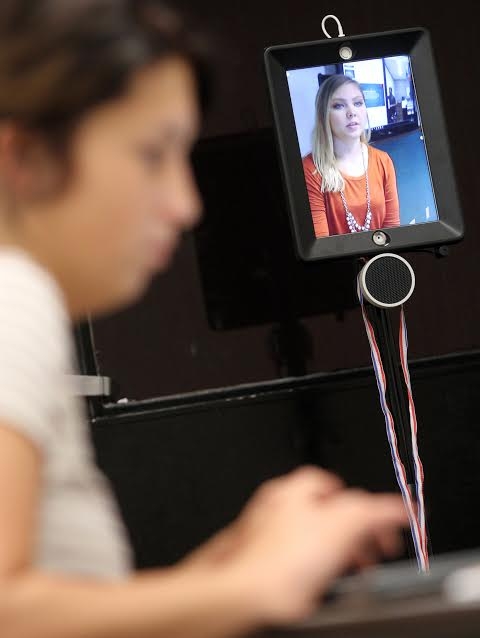You have /5 articles left.
Sign up for a free account or log in.

Marlie Burt communicates through “Sheldon,” a telepresence robot. Burt, who lives 75 miles away from the campus, controls Sheldon with a computer.
Carl Sandburg College
For about $3,000 each, telepresence robots -- which look like iPads mounted on small Segway self-balancing, battery-powered machines -- are making distance learning easier, clearer and more realistic for online students at hundreds of colleges and universities.
Under the direction of their human controllers, these freewheeling machines allow remote students to roam across campus, listen in to conversations, “sit” at a table and participate in group projects. The learner's image and voice are broadcast from a screen on the robot.
At Carl Sandburg College in Galesburg, Ill., for example, criminal justice student Marlie Burt relies on “Sheldon” the robot to attend Dave Kellogg’s Introduction to Criminal Justice class on the main campus.
From a desktop computer at the school’s branch campus 75 miles away, in Carthage, Ill., Burt sees and hears Kellogg and interacts with classmates as if she were at the Galesburg campus herself. She presents in class, shares documents and PowerPoint slides via split screen, and when it’s time for a group project she rolls Sheldon to the table, lowers it a few feet and feels like she’s sitting with her peers, she said.
Sheldon’s intuitive interface took about two minutes to learn, Burt said. “I used to rely only on Skype before, but this really beats that,” she said. “It would sometimes break up and I couldn’t hear people or it would lose connection all together.”
Students in Driver’s Seat
The telepresence approach works well because it puts the distance learner in control, according to Cindy Arthur, an instructional design assistant at Carl Sandburg -- and that’s a welcome change for remote students who often rely on someone to launch a software program in the classroom or send a dial-in number for a conference call. The remote student simply connects to the robot via a smartphone, desktop computer or tablet using a Chrome browser.
Telepresence robots give students who can’t be in the room a sense of autonomy, said Sara Broyles, communications manager for Double Robotics, a Burlingame, Calif.-based manufacturer of the systems. “Remote students simply log into their Double in the classroom and are fully present and able to move around on their own,” she said. “This allows them to feel more engaged.”
The company -- whose telepresence robots are at work at about 400 U.S. institutions, including Duke University, Virginia Tech, the University of Utah and the University of West Florida -- recommends that users on both sides have a strong WiFi or LTE connection for optimal functioning.
Broyles said that Double Robotics’ clients in higher education find unique ways to use their robots. For example, the University of Montana’s Department of Educational Leadership employs multiple units in one class to connect far-flung students, many of whom are working professionals who don’t have time to travel to campus. In a typical class of 14 to 16 students, about six attend via a robot, and the robot-connected students even can collaborate with each other, she said.
At Smith College, “Stella” the telepresence robot recently stood in for a psychology professor who had knee surgery, allowing the professor to continue to teach her class. Setting up Smith’s system was easy, said instructional technologist Yasmin Eisenhauer.
“It’s just a matter of attaching the three components: the base, which is the wheel, the telescoping pole and then you install your iPad,” she said.
Eisenhauer likes that the compatibility with a range of devices. “You can download and drive it using an iOS device, or if you’re using a laptop or PC, you can launch it using a Chrome browser and drive it using your keyboard commands.”
Multiple Campus Benefits
Telepresence technology makes sense for college systems with multiple campuses. For example, as reported in Inside Digital Learning, Rutgers University is employing the technology to allow instructors to teach simultaneously at two campuses to reduce student commute times and classroom sizes. Eleven Rutgers instructors are piloting the technology.
Although half the students in Sara Campbell’s 200-person lecture at Rutgers in New Brunswick, N.J. sit in a room at a campus several miles from where she's teaching, she told Inside Digital Learning her large physiology course feels personal.
“I can without a doubt say that the students feel much closer than in one of the big lecture halls,” said Campbell, an assistant professor in the department of kinesiology and health.
Kellogg said telepresence technology is especially helpful for the rural Carl Sandburg College. ”We have 10 counties and thousands of miles to cover,” he said. “We have used every bit of technology we can to connect those students in other parts of our area to the main campus and to each other.”
The institution is about to purchase two more robots; all three will be available to students and professors for free via a reservation system.
Having humanlike gadgets roaming around classrooms may seem disruptive, but Kellogg said tech-savvy college students take it in stride. “Within five minutes they forget it’s a robot and just start interacting with it,” he said. “It feels so natural to them.”








